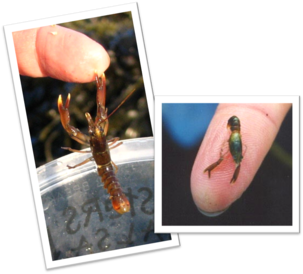 Locust of the Sea - Lobster
A junvenile lobster on a research data sheet from when I volunteered with a lobster monitoring program.
Many people’s only experience with a Maine lobster (Homarus americanus) is seeing it served up on a plate or in a seafood market holding tank. These lobsters, on average, are about seven years old. Each started life as one of thousands of eggs attached to the underbelly (abdomen) of an adult female. There they stay for nine to twelve months. Once hatched, the larvae cling to their mother’s hairy swimmerets until she releases them to float to the ocean surface and drift with the currents. Thus, they are part of the plankton of the sea. After several molts, they will begin their life as sea bottom dwellers. They search out shelter under rocks and may also tunnel in under eel grasses to hide from the crabs and fishes for whom they are an easy meal. Rocky intertidal zones are important as lobster nurseries – places where young lobsters can hide, feed, and grow until they are large enough to move into deeper waters and confront larger predators. They will need rocky areas for protective shelters in the deep waters too.

The two photos each show a small juvenile bottom-dwelling lobster compared to my index finger. They are so much smaller than the lobster photographed on the data sheet, but all three came from the same research transect area. The larger of the three is getting pretty close to being large enough to move on to deeper waters. The other two will need several years and many more molts (shedding of their exoskeleton) to reach its size.
|
Interesting Facts
- Ancient Romans called lobster, locusta. They called locusts locusta as well. So the lobster was the locust of the sea! Lobsters are arthropods, as are insects, so the name makes sense.
- Lobsters have no inner skeleton or bones. They are completely dependent on their exoskeleton for support.
- American lobsters (Homarus americanus) have a large claw with big "teeth" that is used for crushing, and pincher claw, with fine "teeth," used for tearing.
- Spiny lobsters (Panulirus argus)have been seen migrating across the ocean floor, one after the other, in long chains.
Continue Learning
Share Nature Note with your friends, family, teachers, scouts, and anyone you think might be interested. Here is how they can sign up for a free subscription:
Read back issues online.
Suggest a topic by email; put Nature Note in Subject line and email Jocelyn Hubbell.
|